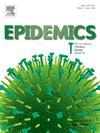A CFD-informed barn-level swine disease dissemination model and its use for ventilation optimization
IF 2.4
3区 医学
Q2 INFECTIOUS DISEASES
引用次数: 0
Abstract
The airborne spread of infectious livestock diseases plays a crucial role in the propagation of epidemics, particularly in populations confined to densely populated facilities, such as commercial swine barns. In this study, we present a framework to study airborne disease dissemination within commercial swine barns and facilitate the strategic design of control actions, including optimization of ventilation and placement of sick animals (sick pen). This framework is based on a susceptible–infected–recovered (SIR) model that accounts for the between-pen disease spread within swine barns. A pen-to-pen contact network is used to construct a transmission matrix according to the transport of airborne respiratory pathogens across pens in the barns, via our Reynolds-averaged Navier–Stokes computational fluid dynamics (CFD) solver. By employing this CFD-augmented SIR model, we demonstrated that the location of the sick pen and the barn ventilation configuration played crucial roles in modifying disease dissemination dynamics at the barn level. In addition, we examined the effect of natural ventilation through different curtain adjustments. We observed that curtain adjustments either suppress the disease spread by an average of 64.8% or exacerbate the outbreak potential by an average of 5.8%, compared to the scenario where side curtains are not raised. Furthermore, we optimize the ventilation configuration via the selection and placement of ventilation fans through the integration of the CFD-augmented framework with the genetic algorithm to minimize the dissemination of swine disease within barns. Compared to the original barn ventilation settings, our optimized ventilation system significantly reduced disease spread by an average of 20%. Our study demonstrates that the use of the proposed framework provides a detailed understanding of the flow physics and the transport of airborne pathogens, which facilitate the optimization of ventilation systems and strategic management of sick pens within the swine barns.
基于cfd的猪舍级猪疾病传播模型及其在通风优化中的应用
传染性牲畜疾病的空气传播在流行病的传播中起着至关重要的作用,特别是在被限制在人口密集设施(如商业猪舍)内的人群中。在本研究中,我们提出了一个研究商业猪舍内空气传播疾病的框架,并促进控制行动的战略设计,包括优化通风和病畜(病栏)的放置。这个框架是基于一个易感-感染-恢复(SIR)模型,该模型解释了猪舍内猪圈间疾病的传播。通过reynolds -average Navier-Stokes计算流体动力学(CFD)求解器,利用笔对笔的接触网络,根据空气传播的呼吸道病原体在畜舍内的传播构建传播矩阵。通过使用这种cfd增强SIR模型,我们证明了病栏的位置和畜棚通风配置在畜棚水平改变疾病传播动态方面起着至关重要的作用。此外,我们通过不同的窗帘调节来检验自然通风的效果。我们观察到,与不抬高侧窗帘的情况相比,调整窗帘或平均抑制疾病传播64.8%,或平均加剧爆发潜力5.8%。此外,我们通过将cfd增强框架与遗传算法相结合,通过通风机的选择和放置来优化通风配置,以最大限度地减少猪舍内猪疾病的传播。与原有的谷仓通风设置相比,我们优化的通风系统显着降低了疾病传播的平均20%。我们的研究表明,使用所提出的框架可以详细了解空气传播病原体的流动物理和运输,这有助于优化猪舍内的通风系统和病栏的战略管理。
本文章由计算机程序翻译,如有差异,请以英文原文为准。
求助全文
约1分钟内获得全文
求助全文
来源期刊

Epidemics
INFECTIOUS DISEASES-
CiteScore
6.00
自引率
7.90%
发文量
92
审稿时长
140 days
期刊介绍:
Epidemics publishes papers on infectious disease dynamics in the broadest sense. Its scope covers both within-host dynamics of infectious agents and dynamics at the population level, particularly the interaction between the two. Areas of emphasis include: spread, transmission, persistence, implications and population dynamics of infectious diseases; population and public health as well as policy aspects of control and prevention; dynamics at the individual level; interaction with the environment, ecology and evolution of infectious diseases, as well as population genetics of infectious agents.
 求助内容:
求助内容: 应助结果提醒方式:
应助结果提醒方式:


